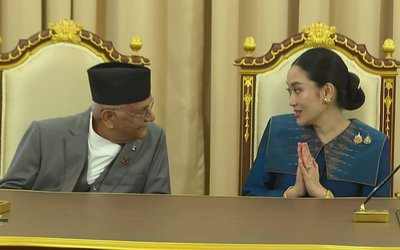When he took the position of the government’s chief secretary, Leelamani Paudyal, a courageous and dynamic bureaucrat, declared he would initiate reforms in the civil service, injecting some hope in a stagnating institution. Paudyal directed civil servants to work as servants of the people and make service delivery effective and timely. He also stressed the need to maintain dignity and decorum of civil service while in the office.
However, less than a week after chief secretary Paudyal’s statement, a group of civil servants affiliated to the various political parties went to the Ministry of General Administration and vandalized the rooms of senior officials, expressing anger over the transfer of civil servants.
This was a reaction against the government’s August 17 decision to transfer 550 civil servants. Disgruntled trade unions affiliated to the ruling UCPN (Maoist) and the Rastriya Karmachari Sangthan traded verbal barbs with officials at the Ministry of General Administration and tried to manhandle them. Another union, Nijamati Karmachari Union, supported by the Nepali Congress, picketed the office of the chief secretary.
A tug of war has been brewing between the government and the trade unions after the MoGA shuffled some 550 civil servants, some 400 non-gazetted and 150 gazetted staff in all the categories. The reshuffle has resulted in some old faces serving in ‘attractive’ offices for many years, replaced by new ones.
Up in arms are civil servants unions, including CPN-UML aligned Nepal Civil Servants Employees Association, Nepal Civil Servants Employees Union, Nepali Congress, Nepal Civil Servants Association (NC splinter), Nepal National Civil Servants Employees Association (UCPN-Maoist), Nepal Madheshi Civil Service Association, National Independent Civil Service Union (Drivers and class less employees) and Nepal National Employees Forum. All Nepal Government, Temporary, Daily Wages and Contract Employees Association adds to the strength.
As the civil service is badly divided, every employee needs the backing of certain group to register his or her voice. "If I cannot join one or the other group, nobody will come to support me at the time of transfers and promotions," said an employee.
Due to the growing insecurity, civil servants are joining unions for their protection.
Each organization needs 5,000 signatures to register it at the Labor Department and get the recognition as a trade union.
As soon as the transfer is announced, the Ministry of General Administration comes under fire from trade unions. Last April, trade unions shut down the doors of senior officials, including those of the secretaries, joint secretaries and under secretaries for months. According to Nepal Civil Service Act, the transfer of the civil service is made twice a year, in April and August. The dispute surfaces if employees associated with trade unions are not posted to lucrative ministries.
Classification
As disputes in transfer grow in the midst of rampant charge of ‘systemic corruption,’ the government has classified ministries, departments and offices into four categories. However, trade unions have denounced the move to categorize the government offices into ‘Ka, Kha, Ga and Gha’ (A, B, C and D) classes as an attempt to breed corruption.
Sources claimed that PM Baburam Bhattarai in his capacity as the Minister for General Administration (MoGA), Chief Secretary Lila Mani Paudyal, MoGA Secretary Durga Nidhi Sharma and seven trade unions on August 14 decided on the classification.
Government officials said the move was an attempt to ‘end systemic corruption’ in public offices that are considered ‘attractive.’ They added that the move was also an honest effort to bring about sanity and deliver effective services to the people.
‘Attractive’ ministries and offices like the Ministry of Labor and Transport Management, Foreign Employment Department, the Department of Transport, Ministry of Physical Planning and Works and its departments, Ministry of Land Reforms, Land Revenues Department, Revenue Offices, Immigration Offices and some district administration offices, including Kathmandu, Lalitpur and Bhaktapur, fall under the A category.
The B category includes Ministries like Industry and its departments, the Company Registrar’s Office, Department of Commerce and some district administrative offices, the Ministry of Youth and Sports, Ministry of Soil and Conservation, Ministry of Irrigation, its departments and office of auditors.
The C category of Ministries includes Agriculture, Tourism and their offices, Education, Health and Population and their offices. Under D category, there are post offices, District Development Offices, Office of the Regional Administration and offices of constitutional bodies and the Ministry of Children and Women.
“"The same unions are now protesting the move,” Shovakhar Regmi, the chairman of the Nepali Nijamati Karmachari Sangh, another Congress-affiliated trade union, told the Kantipur daily, recently.
Since Nepal drafted the first Civil Service Act in 1957, it underwent 29 revisions before being replaced by Nepal Civil Service Act 1993, which was amended in 2007 to make it inclusive. Several structural reforms, such as the setting up of computer-based personnel information systems, the passage of legislation for rightsizing the government, and the Civil Service Act of 2007, are important achievements.
In order to make the civil service inclusive, Section 7 (7) of the Civil Service Act, 1992 (Second Amendment 2007) section 14 has made some important provisions on reservation and recruitment policy and process. Forty five percent of the posts to be filled through open competition are to be set aside and filled up through separate competition, exclusively between the candidates from women, indigenous/nationalities, Madhesi, Dalit, disabled and backward areas, which share 33, 27, 22, 9, 5 and 4 percent, respectively.
A total of 79,763 permanent civil servants are currently working in the country (this number also includes 15702 from Health services). Out of 63,927 civil servants, 5,841 are females. There are 13,440 gazetted officers, with 946 of them females. The gazetted category includes 52 special classes, 492 first class, 3,021 second class and 9,875 third class. There are two females in special class, 12 in first class, 107 in second class and 825 in third class.
“"The same unions are now protesting the move,” Shovakhar Regmi, the chairman of the Nepali Nijamati Karmachari Sangh, another Congress-affiliated trade union, told the Kantipur daily, recently.
Since Nepal drafted the first Civil Service Act in 1957, it underwent 29 revisions before being replaced by Nepal Civil Service Act 1993, which was amended in 2007 to make it inclusive. Several structural reforms, such as the setting up of computer-based personnel information systems, the passage of legislation for rightsizing the government, and the Civil Service Act of 2007, are important achievements.
In order to make the civil service inclusive, Section 7 (7) of the Civil Service Act, 1992 (Second Amendment 2007) section 14 has made some important provisions on reservation and recruitment policy and process. Forty five percent of the posts to be filled through open competition are to be set aside and filled up through separate competition, exclusively between the candidates from women, indigenous/nationalities, Madhesi, Dalit, disabled and backward areas, which share 33, 27, 22, 9, 5 and 4 percent, respectively.
A total of 79,763 permanent civil servants are currently working in the country (this number also includes 15702 from Health services). Out of 63,927 civil servants, 5,841 are females. There are 13,440 gazetted officers, with 946 of them females. The gazetted category includes 52 special classes, 492 first class, 3,021 second class and 9,875 third class. There are two females in special class, 12 in first class, 107 in second class and 825 in third class.
Out of 29,143 total non gazette staff, 3,356 are females. There are 13,850 non-gazetted first class, 12,753 second class, 2092 third class, 434 fourth class and 14 fifth class staff. Out of 21,344 class less employees, 1,539 are females. Out of total employees, there are 15,702 in the health sector with 5,972 females there. Likewise, there are 129 people, including 2 women, in the judiciary.
Although Nepal's civil service has been transformed from an isolated tower to a more inclusive institution, the challenges remain before it to make it a public oriented and effective instrument to deliver services to the people. .








